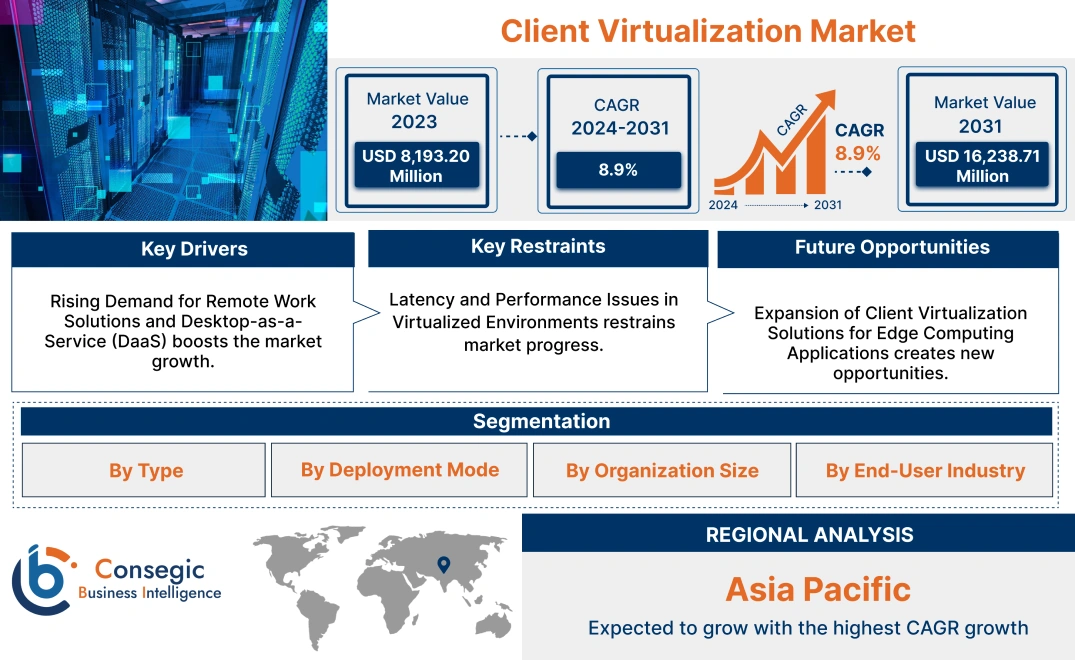- Summary
- Table Of Content
- Methodology
Client Virtualization Market Size:
The client virtualization market size is estimated to reach over USD 16,238.71 Million by 2031 from a value of USD 8,193.20 Million in 2023 and is projected to grow by USD 8,778.69 Million in 2024, growing at a CAGR of 8.9% from 2024 to 2031.
Client Virtualization Market Scope & Overview:
Client virtualization refers to the technology that separates the user's desktop environment from the physical device, allowing applications and desktops to be hosted on centralized servers and accessed remotely. This approach enables businesses to centralize desktop management, improve security, and streamline IT operations while providing users with flexible access to their desktop environments from any device. It encompasses virtual desktop infrastructure (VDI), application virtualization, and remote desktop services, offering efficient resource utilization and enhanced system performance. The market serves industries such as healthcare, finance, and education, where secure, scalable, and efficient desktop management is essential. Solutions in this market enable businesses to reduce hardware costs, simplify IT management, and improve disaster recovery capabilities. As organizations continue to focus on improving operational efficiency and providing flexible work environments, client virtualization technologies are becoming increasingly integrated into enterprise IT infrastructures.
Key end-users of client virtualization solutions include large enterprises, small and medium-sized businesses (SMBs), IT service providers, and managed service providers. The market continues to evolve with advancements in cloud computing, providing businesses with enhanced scalability and more flexible solutions for managing their virtual desktop environments.
Client Virtualization Market Dynamics - (DRO) :
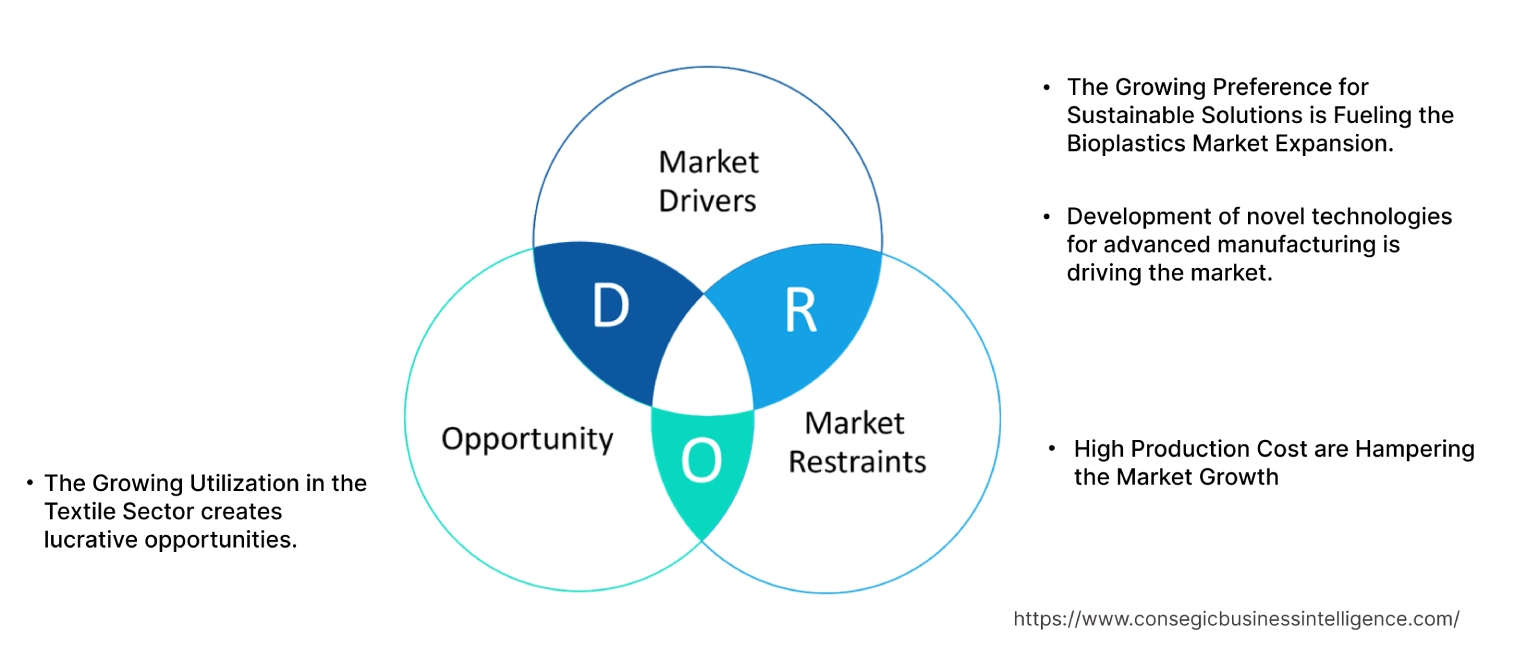
Key Drivers:
Rising Demand for Remote Work Solutions and Desktop-as-a-Service (DaaS) boosts the market growth.
The increasing adoption of remote work models and the growing popularity of Desktop-as-a-Service (DaaS) are key drivers in the market. The shift towards remote and hybrid work environments, accelerated by the COVID-19 pandemic, has made it essential for organizations to provide secure, remote access to corporate desktops and applications. Client virtualization solutions, including Virtual Desktop Infrastructure (VDI) and DaaS, enable employees to access their work environments from any location and device, improving flexibility and productivity. These solutions offer centralized management, enhanced data security, and the ability to scale resources up or down based on user demand. The trend towards remote work is particularly strong in sectors like IT, finance, and professional services, where the need for secure, seamless access to business applications is critical. Therefore, the growing adoption of remote work models and the rise of Desktop-as-a-Service (DaaS) are driving the client virtualization market growth.
Growing Adoption of Bring Your Own Device (BYOD) Policies fuels market development.
The widespread adoption of Bring Your Own Device (BYOD) policies is another significant driver for the market. As organizations embrace flexible work environments and allow employees to use their personal devices for work, the need for secure, consistent access to corporate applications has increased. Client virtualization solutions, including Virtual Desktop Infrastructure (VDI) and Desktop-as-a-Service (DaaS), enable users to access their virtual desktops securely from any device, regardless of the operating system or hardware. This capability enhances employee productivity, supports mobility, and reduces the need for corporate-issued hardware, aligning well with the growing trend of BYOD. By offering a secure, device-agnostic platform, helps organizations balance the flexibility of BYOD with stringent security and compliance requirements. Thus, the widespread adoption of Bring Your Own Device (BYOD) policies is driving the client virtualization market demand.
Key Restraints :
Latency and Performance Issues in Virtualized Environments restrains market progress.
The latency and performance issues associated with client virtualization solutions impact user experience, particularly in scenarios requiring high-performance computing or real-time applications. Virtual desktops rely on a stable network connection to stream applications and data from the server to the endpoint device. In environments with limited bandwidth or high network latency, users may experience delays, reduced application responsiveness, and degraded video or graphic performance. These issues are especially problematic for industries that require real-time data processing or use resource-intensive applications, such as CAD software in engineering or video editing in media production. Ensuring a consistent, high-quality user experience requires significant investment in network optimization and infrastructure upgrades, which is challenging for organizations with limited IT resources. In conclusion, latency and performance challenges present a significant barrier hampering client virtualization market expansion.
Future Opportunities :
Expansion of Client Virtualization Solutions for Edge Computing Applications creates new opportunities.
The growing adoption of edge computing presents a unique opportunity for the market. As businesses deploy edge computing infrastructure to process data closer to the source, there is a rising need for virtualization solutions that will extend to the edge. Client virtualization at the edge enables low-latency access to applications and data, improving performance for time-sensitive tasks and reducing the dependency on centralized cloud resources. Industries such as manufacturing, telecommunications, and logistics are leveraging edge-based client virtualization to enhance real-time decision-making, support IoT applications, and optimize resource utilization. The integration with edge computing environments offers new possibilities for improving application performance and scalability, creating potential client virtualization market opportunities.
Client Virtualization Market Segmental Analysis :
By Type:
Based on type, the Market is segmented into desktop virtualization, application virtualization, and presentation virtualization.
The desktop virtualization segment accounted for the largest revenue of the total client virtualization market share in 2023.
- Desktop virtualization enables users to access a virtual desktop environment hosted on a centralized server, providing a consistent experience across devices.
- It allows businesses to reduce hardware costs, enhance data security, and streamline IT management by centralizing desktop operations.
- Leading solutions, such as Virtual Desktop Infrastructure (VDI), are widely adopted by enterprises for remote work and secure access to corporate resources.
- The increasing demand for remote work solutions and enhanced endpoint security is driving the growth of desktop virtualization.
- The desktop virtualization segment dominates the market due to its broad adoption across various industries and its ability to support flexible work environments further fueling the client virtualization market demand.
The presentation virtualization segment is anticipated to register the fastest CAGR during the forecast period.
- Presentation virtualization, also known as remote presentation, allows users to run applications on a centralized server while interacting with the application interface on their local devices.
- This approach reduces the need for powerful local hardware, as the application processing is handled on the server, making it cost-effective for businesses.
- The rising adoption of cloud-based services and the need for scalable application delivery solutions are driving the growth of presentation virtualization.
- Advanced technologies like Remote Desktop Services (RDS) and Citrix Virtual Apps enhance user experience by providing seamless access to applications over the internet.
- Thus, the analysis of segmental trends shows that presentation virtualization segment is expected to grow rapidly due to its efficiency in delivering applications across diverse user environments with minimal infrastructure requirements creating client virtualization market opportunities.
By Deployment Mode:
Based on deployment mode, the market is segmented into on-premise, cloud-based, and hybrid.
The cloud-based segment accounted for the largest revenue of 53.47% of the total client virtualization market share in 2023.
- Cloud-based solutions offer scalability, flexibility, and cost savings, making them a popular choice for organizations transitioning to cloud infrastructure.
- These solutions eliminate the need for extensive on-premise hardware, reducing maintenance costs and enabling businesses to scale their virtual environments quickly.
- Leading providers like Amazon Web Services (AWS), Microsoft Azure, and Google Cloud offer robust cloud-based virtualization services, enhancing accessibility and performance.
- The shift towards cloud adoption, driven by digital transformation initiatives, supports the strong market position of cloud-based deployments.
- The cloud-based segment leads due to its ease of implementation, scalability, and growing preference among organizations seeking cost-effective virtualization solutions fueling the client virtualization market growth.
The hybrid deployment segment is expected to register the fastest CAGR during the forecast period.
- Hybrid deployment combines on-premise infrastructure with cloud resources, providing a balanced approach that offers flexibility, scalability, and enhanced data control.
- This model is particularly attractive to enterprises with complex IT environments, as it allows for the secure handling of sensitive data on-premise while leveraging the cloud for less critical applications.
- The growing trend of multi-cloud strategies and the increasing need for flexible deployment options are driving the adoption of hybrid virtualization solutions.
- Hybrid models offer businesses the ability to optimize performance and cost-efficiency by dynamically distributing workloads across on-premise and cloud environments.
- As per client virtualization market analysis, the hybrid deployment segment is expected to grow rapidly due to its ability to meet diverse business needs and provide flexible and secure solutions.
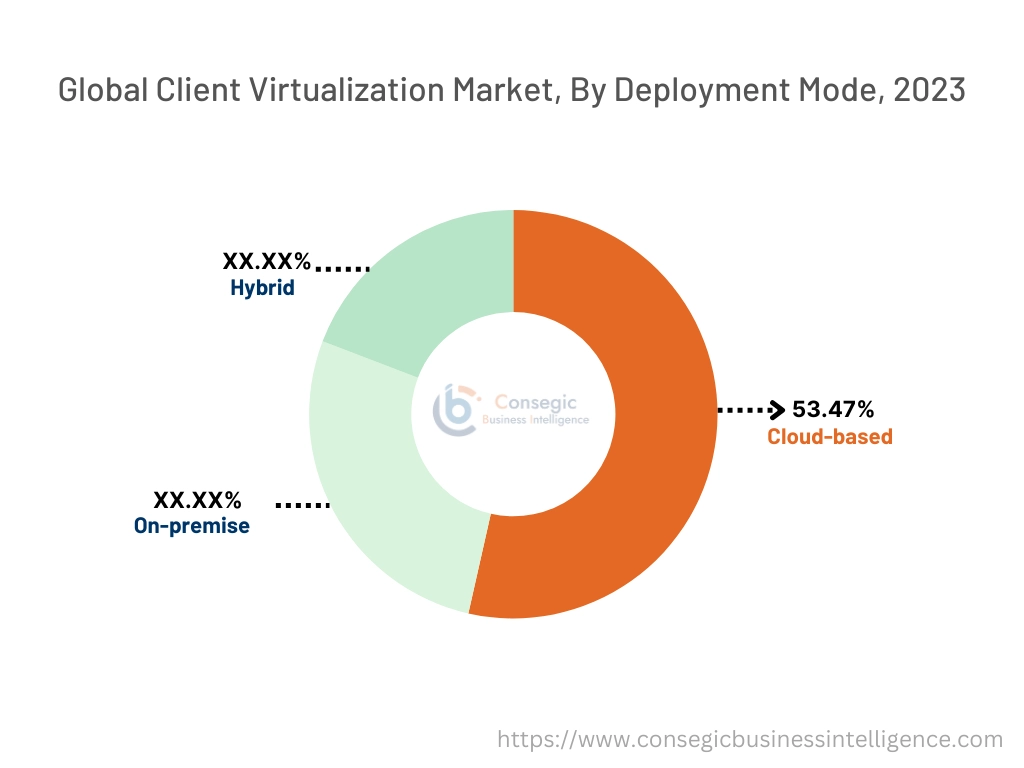
By Organization Size:
Based on organization size, the market is segmented into small & medium enterprises (SMEs) and large enterprises.
The large enterprises segment held the largest market share in 2023.
- Large enterprises typically manage complex IT infrastructures with diverse requirements, necessitating robust solutions to streamline operations.
- These organizations leverage client virtualization to enhance data security, simplify IT management, and support remote access for a distributed workforce.
- The increasing focus on digital transformation and the need for scalable solutions to manage large volumes of data are driving the adoption among large enterprises.
- Advanced features like centralized management, enhanced security controls, and integration with existing enterprise software make client virtualization attractive to large businesses.
- As per client virtualization market trends, the dominance of the large enterprises segment is due to their substantial investments in virtualization technologies and their focus on optimizing IT operations.
The SMEs segment is expected to register the fastest CAGR during the forecast period.
- SMEs are increasingly adopting client virtualization solutions to improve operational efficiency, reduce costs, and enhance IT flexibility without significant capital investment.
- Cloud-based virtualization offerings are particularly appealing to SMEs, as they provide scalable, cost-effective solutions that are tailored to the needs of smaller businesses.
- The rising trend of remote work and the need for secure, flexible access to business applications are key drivers of virtualization adoption among SMEs.
- SMEs benefit from simplified IT management and lower hardware requirements, allowing them to focus resources on core business activities.
- As per client virtualization market analysis, the SMEs segment is expected to grow rapidly, supported by the increasing availability of affordable, cloud-based virtualization solutions tailored to the needs of smaller organizations.
By End-User Industry:
Based on end-user industry, the market is segmented into IT & telecom, BFSI, healthcare, education, and government & public sector.
The IT & telecom segment accounted for the largest revenue share in 2023.
- The IT & telecom sector is a major user of client virtualization technologies, leveraging them to manage extensive IT infrastructure, enhance data security, and streamline operations.
- It helps telecom companies provide consistent user experiences, support remote work, and reduce the complexity of managing diverse endpoints.
- The adoption of advanced technologies like 5G and the increasing use of cloud services in the telecom sector are driving demand for robust virtualization solutions.
- As per client virtualization market trends, the IT & telecom segment leads due to its early adoption of virtualization technologies and the need to support large-scale, complex IT environments.
The healthcare segment is expected to register the fastest CAGR during the forecast period.
- The healthcare sector requires secure client virtualization solutions to manage sensitive patient data, ensure compliance with regulations, and support telemedicine services.
- Virtualization technologies help healthcare providers enhance data accessibility, streamline operations, and improve patient care by enabling secure, remote access to medical applications.
- The increasing adoption of electronic health records (EHRs) and the extension of telemedicine services have accelerated the need for effective virtualization solutions in healthcare.
- Thus, the healthcare segment is projected to grow rapidly due to the rising focus on data security, compliance, and the adoption of digital health technologies further driving the client virtualization market expansion.
Regional Analysis:
The regions covered are North America, Europe, Asia Pacific, the Middle East and Africa, and Latin America.
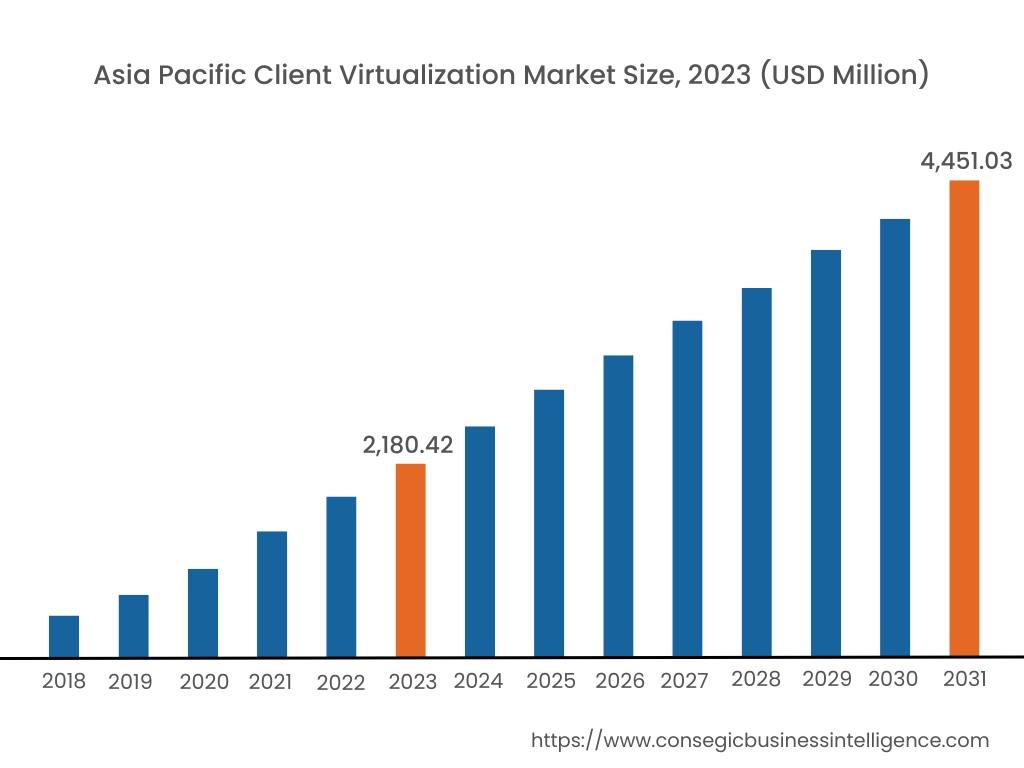
Asia Pacific region was valued at USD 2,180.42 Million in 2023. Moreover, it is projected to grow by USD 2,342.06 Million in 2024 and reach over USD 4,451.03 Million by 2031. Out of these, China accounted for the largest share of 29.8% in 2023. Asia-Pacific is witnessing rapid growth in the market, particularly in China, Japan, and India. The region's expanding IT industry, combined with the surge in digitalization and cloud adoption, drives the uptake of client virtualization solutions. Companies in Asia-Pacific are leveraging virtualization to enhance data security and reduce hardware dependency, particularly as remote work gains traction. Government initiatives supporting cloud adoption and the digital economy, especially in China and India, further support market expansion.
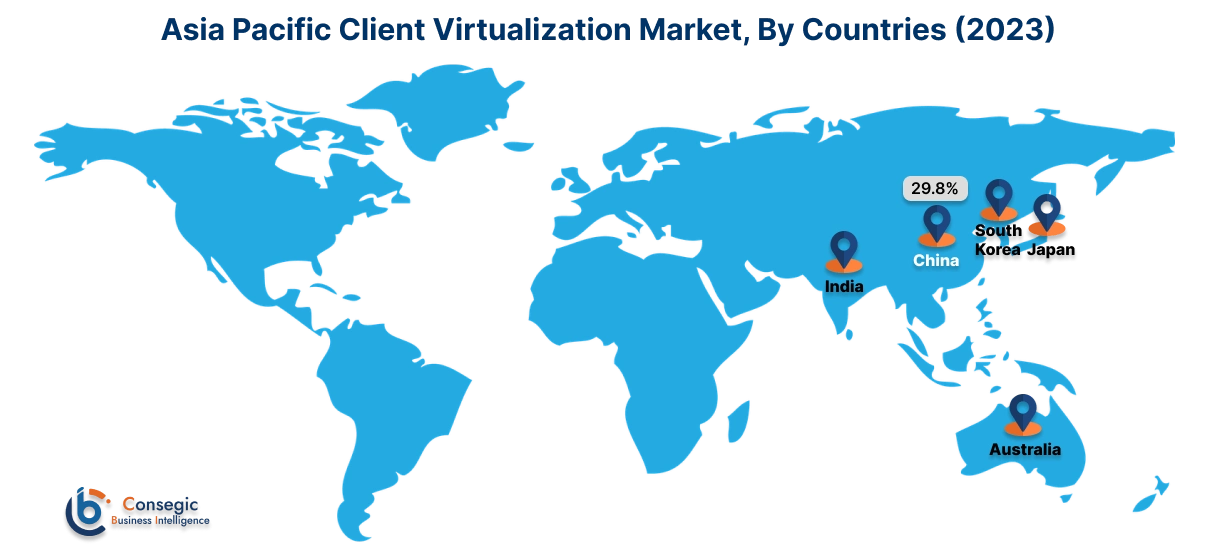
North America is estimated to reach over USD 5,629.96 Million by 2031 from a value of USD 2,809.79 Million in 2023 and is projected to grow by USD 3,013.33 Million in 2024. North America holds a leading position in the market, driven by strong demand from sectors such as IT, BFSI (Banking, Financial Services, and Insurance), and healthcare. The U.S. is a major contributor, with enterprises rapidly adopting virtual desktop infrastructure (VDI) solutions to enhance workforce mobility, secure data access, and improve operational efficiency. High investments in cloud infrastructure and a tech-savvy user base propel the market forward.
Europe represents a significant share of the global market, with key contributions from Germany, the UK, and France. The market benefits from the region's strong emphasis on digital workplace transformation and remote work trends. European businesses are increasingly adopting virtualization solutions to reduce IT costs and streamline operations. The rise of hybrid work models post-pandemic has further accelerated the need for VDI and application virtualization.
The Middle East & Africa (MEA) region shows promising growth potential in the market, particularly in the UAE and Saudi Arabia. With an increasing focus on digital transformation and the adoption of smart city initiatives, there is a growing need for secure and scalable virtualization solutions. Organizations are increasingly investing to optimize IT resources and enhance data security across remote and distributed workforces.
Latin America is an emerging market for client virtualization, with Brazil and Mexico leading the adoption. The region's growing focus on digital transformation, coupled with increasing adoption of cloud services, drives need for client virtualization solutions across industries such as education, banking, and retail. Companies in the region are looking to enhance their IT infrastructure to support remote work and improve data security, which supports market progress.
Top Key Players & Market Share Insights:
The Client Virtualization market is highly competitive with major players providing products and services to the national and international markets. Key players are adopting several strategies in research and development (R&D), product innovation, and end-user launches to hold a strong position in the global Client Virtualization market. Key players in the Client Virtualization industry include –
- VMware, Inc. (USA)
- Citrix Systems, Inc. (USA)
- Microsoft Corporation (USA)
- Nutanix, Inc. (USA)
- Red Hat, Inc. (USA)
- Parallels International GmbH (USA)
- IGEL Technology GmbH (Germany)
- Amazon Web Services, Inc. (USA)
- Oracle Corporation (USA)
- IBM Corporation (USA)
Recent Industry Developments :
Product Launches:
- In September 2024, MacStadium announced the general availability of Orka Desktop 3.0, a powerful macOS virtualization tool designed for developers and IT teams. This release includes enhanced support for macOS 15 Sequoia and features a graphical interface for managing macOS virtual machines on Apple silicon. Orka Desktop 3.0 also supports OCI-compliant images and offers day-one compatibility with the latest macOS versions, simplifying virtualization workflows for macOS technologists.
Acquisitions & mergers:
- In February, 2024, KKR announced its acquisition of Broadcom's End-User Computing (EUC) Division for $4 Million. This division, known for products like Horizon and Workspace ONE, provides digital workspace solutions, including desktop and application virtualization and unified endpoint management. Post-acquisition, the EUC Division will operate as a standalone entity, focusing on product innovation, R&D, and customer relationships with increased investment. This move aims to drive growth and improve customer outcomes in the expanding digital workspace market.
Product Enhancements:
- In November 2024, Citrix announced the general availability of Citrix DaaS for Amazon WorkSpaces Core. This solution integrates Citrix's cloud desktop services with Amazon's WorkSpaces Core to offer businesses a cost-effective, secure, and high-performance way to deliver virtual desktops and apps. It supports Microsoft 365 Apps, provides flexible compute pricing, and includes enhanced security features like encrypted disk support. The solution is designed to improve IT operations while enhancing user experience across devices and locations.
Client Virtualization Market Report Insights :
| Report Attributes | Report Details |
| Study Timeline | 2018-2031 |
| Market Size in 2031 | USD 16,238.71 Million |
| CAGR (2024-2031) | 8.9% |
| By Type |
|
| By Deployment Mode |
|
| By Organization Size |
|
| By End-User Industry |
|
| By Region |
|
| Key Players |
|
| North America | U.S. Canada Mexico |
| Europe | U.K. Germany France Spain Italy Russia Benelux Rest of Europe |
| APAC | China South Korea Japan India Australia ASEAN Rest of Asia-Pacific |
| Middle East and Africa | GCC Turkey South Africa Rest of MEA |
| LATAM | Brazil Argentina Chile Rest of LATAM |
| Report Coverage |
|
Key Questions Answered in the Report
How big is the Client Virtualization market? +
The client virtualization market size is estimated to reach over USD 16,238.71 Million by 2031 from a value of USD 8,193.20 Million in 2023 and is projected to grow by USD 8,778.69 Million in 2024, growing at a CAGR of 8.9% from 2024 to 2031.
What specific segmentation details are covered in the Client Virtualization Market report? +
The Client Virtualization market report includes segmentation details for type (desktop virtualization, application virtualization, presentation virtualization), deployment mode (on-premise, cloud-based, hybrid), organization size (small & medium enterprises and large enterprises), end-user industry (IT & telecom, BFSI, healthcare, education, government & public sector), and region.
Which is the fastest-growing segment in the Client Virtualization market? +
According to the analysis, the presentation virtualization segment is expected to register the fastest CAGR during the forecast period, driven by its efficiency in delivering applications across diverse user environments with minimal infrastructure requirements.
Who are the major players in the Client Virtualization market? +
The major players in the Client Virtualization market include VMware, Inc. (USA), Citrix Systems, Inc. (USA), Microsoft Corporation (USA), Nutanix, Inc. (USA), Red Hat, Inc. (USA), Parallels International GmbH (USA), IGEL Technology GmbH (Germany), Amazon Web Services, Inc. (USA), Oracle Corporation (USA), and IBM Corporation (USA).
